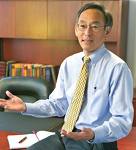Tuesday, January 20th, 2009
Just over five years ago, I was one of the steering committee members of the MIT • Stanford • UC Berkeley Nanotechnology Forum, and had the pleasure of meeting new U.S. Energy Secretary Steven Chu when he was one of the presenters at our first event, “Nanotech beyond the hype,” held May 29, 2003 at Stanford University.
Nanotechnology Forum, and had the pleasure of meeting new U.S. Energy Secretary Steven Chu when he was one of the presenters at our first event, “Nanotech beyond the hype,” held May 29, 2003 at Stanford University.
Seeing the potential for nanotech to be hyped even back then, the forum was held to look at the current state-of-the-art in nanotechnology applied to energy, health, information, and other human needs. Providing the pragmatic perspective of a benchmark from nature, Chu showed how human ear cilia have evolved to provide excellent frequency response and automated signal gain, and that humans haven’t even begun to understand how to try to improve upon this design. He showed a unique ability to communicate complex technical topics with clarity, so we may hope that he will be highly effective in directing national policy.
“Simply stating, in my opinion,” Senator Dianne Feinstein of California, said, “there is no one brighter or more equipped than this man to become secretary of energy.” After the hearing, even environmental groups that oppose coal and nuclear plants praised Chu’s commitment to renewable fuels and efficiency. Having been director of Lawrence Livermore National Laboratory, Chu’s opinions about renewable energy technologies like photovoltaic (PV) are on the record. He seems pragmatic and focused, and we need that type of energy leadership now more than ever.
PV fits into the portfolio of renewable energy technologies that includes wind, wave, biomass, and geothermal. All of these technologies seem to have advantages in one location or another, and all seem worthy of funding by the DOE. We may be thankful that NREL has been dutifully working on all aspects of PV technology development for decades, and that some of that work is now ready for production in partnership with HelioVolt. –E.K.
Tags: energy, PV, R&D, solar, technology
